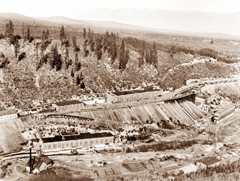
For Bill Roberts, the men and women who plied their trade in Kimberley's Sullivan Mine were the best in the world. Toiling in the wet and the heat, the Sullivan miners dug over 160 million tons of ore out the mountain site in over 90 years of operation, building along the way a reputation as hard, safe producers of iron and zinc.
So when four people died on the site last May, five years after the deposits ran dry, Roberts was shocked. "It [Teck Cominco, the mine's owner] has been one of the safest companies to work for," the former miner said. "If there was an accident or a complaint about a safety issue, it would be fixed."
A coroner's inquest into the four deaths has captivated the small town of about 7,000, which sits in the Kootenay Mountains five hours southwest of Calgary, since it began on Monday. For while the mine closed in 2001, even today it's hard to find someone in Kimberley who didn't either work for Sullivan, or know someone who did.
For a town that has made a rapid and successful transition from resource to tourism, the deaths served as a harsh reminder of the industry that made them what they are. And for this week at least, Kimberley, with its lush green golf courses and picturesque Bavarian buildings, is once again a mining town.
A one-company town
On Howard Street, just outside Kimberley's small downtown core, sits the 21-room Chateau Kimberley Hotel. The three-storey yellow building hosts would-be skiers and golfers today, but just a few years ago it was home to Teck Cominco's local head office, where for years decisions were made and papers signed for the bustling Sullivan Mine.
The mine site was first discovered in 1892. But it wasn't until the old Kimberley Mining Company was reorganized in 1909 that the mine began to produce. A town quickly sprung up on the site to host the many miners who soon poured in from Europe and Eastern Canada. The influence of the town's early Austrian settlers is clear today in the German style downtown platz and the many German restaurants that dot the area.
Bill Roberts worked underground at Sullivan for 36 years. Beginning in the 1980s, Roberts began collecting the stories of his fellow miners for a book that eventually became The Best Miners in the World: Stories from Canada's Sullivan Mine.
"Most of these people had a father, sons, uncles who worked at the mine," Roberts said in a recent interview about his subjects. "They realized what the mine meant for this town."
For most of its life, Kimberley was your prototypical one-company town. On average, more than 1,000 people worked at the mine between 1909 and 2001. And in 1951, 90 per cent of the town's labour force was employed there.
But while the mine gave the town life, it also occasionally brought death. Seventy-three people died in mining-related accidents in the lifetime of the Sullivan Mine. Still, before last year's tragedy, there had not been a fatality at Sullivan for 14 years.
Smooth transition
Mines, of course, don't last forever. And in 1990, the company and the town began to plan for its eventual end. By 2001, when the ore tapped out, Kimberley was well on its way to becoming a mini tourist hub.
Jim Ogilvie has been the mayor of Kimberley for 32 years. "We've been working on the closure plan for 10 to 15 years," he told The Tyee. "It's been very critical."
The town collaborated with Teck Cominco and the provincial government to both reclaim the land and transition from the resource economy. The city built golf courses and souped-up the local ski resort to lure a major private investor.
"We worked hard to prepare the transition from mining to tourism," Ogilvie said. "It's a good community for retirement. And it's affordable."
A painful reminder
The town's mostly painless transition from mining may be one reason last year's accident came as such a shock.
Bob Newcombe, Kim Weitzel, Shawn Currier and Doug Erickson all died in a water sampling shed on the mine site last May. An investigation later determined that super-low oxygen atmosphere had seeped into the shed from a drainage pipe, killing all four over a three-day period.
"When the mine was operating, we never had an accident that had taken so many lives at the same time," Ogilvie said. His community, he added, has had a hard time accepting the incident, especially considering Sullivan's generally "good safety record over the years."
The mine's legacy has also made Kimberley an especially tight community, Ogilvie added. "[A]nything happens in that community, everyone feels it. Everyone knew one or the other of the persons involved. It's quite a loss. That question is always there: how did this happen when the mine is closed?"
Lurking 'below the surface'
From the outside, little is visible today of the "mighty Sullivan," as it was once called. But below the surface, its physical legacy remains. Many of the town's houses sit atop the mine site.
In other ways, too, the late mine's influence lingers. Something the accident, and the inquest, have reminded the people of Kimberley all too many times this week.
Related Tyee Stories:
- Coroner's Inquest Demanded in Sullivan Mine Deaths
Family, union and MLA reject government report. - Inside BC's Mining Boom
Why billions are pouring in for copper, coal, uranium. - Sullivan Mine Deaths: Questions Haunt
Families seek answers in coroner's inquest.














Tyee Commenting Guidelines
Comments that violate guidelines risk being deleted, and violations may result in a temporary or permanent user ban. Maintain the spirit of good conversation to stay in the discussion.
*Please note The Tyee is not a forum for spreading misinformation about COVID-19, denying its existence or minimizing its risk to public health.
Do:
Do not: